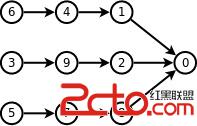非常坑的一道題,最後快要繞暈了。。
題意:有N個球,重量分別是1~N,給著n個球貼上標簽。輸入n,m代表n個球和m條邊(a b),代表 標簽為a的要比標簽為b的輕。最後輸出標簽1~N對應的重量(注意是重量,而不是輕重關系),還有要注意“ you should output the one with the smallest weight for label 1, then with the smallest weight for label 2, then with the smallest weight for label 3 and so on... ”,意思是標簽小的要盡可能貼在重量小的球上。
思路:因為標簽小的要盡可能貼在重量小的球上,所以拓撲排序時要使標簽小的盡可能的靠前。所以只是傳統的拓撲排序每次取優先隊列中入度為0並且數最小的不對的。因為即使該點最小,它後面連著的點未必是最小的。

例如上圖,若先取入度為0且最小的話,是先取出3,而我們的目的是讓標號小的盡量靠前,即應該讓1盡量靠前,這與先取出3相違背,這時應該先取出6才能使1盡量靠前。對於2,8,2肯定先出隊列。歸納起來便是對於若干平行的路徑,小的頭部不一定排在前面(如3),但大的尾部一定排在後面(如8).
1. 把所有出度為 0 的節點放進優先隊列 PQ 2. WHILE: PQ 不是空隊列 3. 從 PQ 中取出編號最大的元素 a,把 a 添加到答案的頭部。 4. FOR:所有指向 a 的邊 b → a 5. 把 b 的出度減 1。如果 b 的出度變為 0,則把 b 放進優先隊列 PQ。
#include#include #include #include using namespace std; int n,m; int out[210]; int topo[210]; int map[210][210]; priority_queue < int, vector ,less > que; int toposort() { while(!que.empty()) que.pop(); int cnt = 1; memset(topo,0,sizeof(topo)); for(int i = 1; i <= n; i++) if(out[i] == 0) que.push(i); while(!que.empty()) { int u = que.top(); //每次取出隊列中最大的 que.pop(); topo[cnt++] = u; for(int i = 1; i <= n; i++) { if(map[i][u] == 1) { out[i]--; if(out[i] == 0) que.push(i); } } } if(cnt == n+1) return 1; return 0; } int main() { int test; scanf(%d,&test); while(test--) { scanf(%d %d,&n,&m); memset(out,0,sizeof(out)); memset(map,0,sizeof(map)); int flag = 1; for(int i = 0; i < m; i++) { int a,b; scanf(%d %d,&a,&b); if(!map[a][b]) { map[a][b] = 1; out[a]++; } if(a == b) flag = 0; } if(!flag) { printf(-1 ); continue; } int tmp[210]; int ans = toposort(); if(ans == 0) printf(-1 ); else { for(int i = 1; i <= n; i++) tmp[ topo[i] ] = n+1-i; //編號,tmp[]存的是拓撲排序的逆序. for(int i = 1; i <= n-1; i++) printf(%d ,tmp[i]); //輸出編號1~n對應的重量 printf(%d ,tmp[n]); } } return 0; }